Environmental Management Systems: Consumer Perception in Australia
VerifiedAdded on 2023/06/07
|9
|2364
|56
Report
AI Summary
This report examines the implementation of Environmental Management Systems (EMS) in Australia, focusing on consumer environmental perceptions regarding agricultural products. It highlights the shift in consumer focus towards the environmental impact of food production and discusses various programs like ISO 14001 that provide guidelines for environmental management. The report emphasizes the importance of life cycle assessment (LCA) in understanding the environmental impacts of products and processes, detailing the forces driving LCA adoption, including government regulations and voluntary business participation. It also explores programs used in Australia for EMS implementation, such as the organic standard developed by the National Association of Sustainable Agriculture Australia (NASSA) and best management practices in the cotton industry. Furthermore, the report suggests strategies for successful EMS implementation, including clear market signals, regulatory checkpoints, farmer education, and harmonized systems with specific sustainability indicators. It concludes by advocating for a collaborative approach to address the degradation of resources in Australia's production sectors.
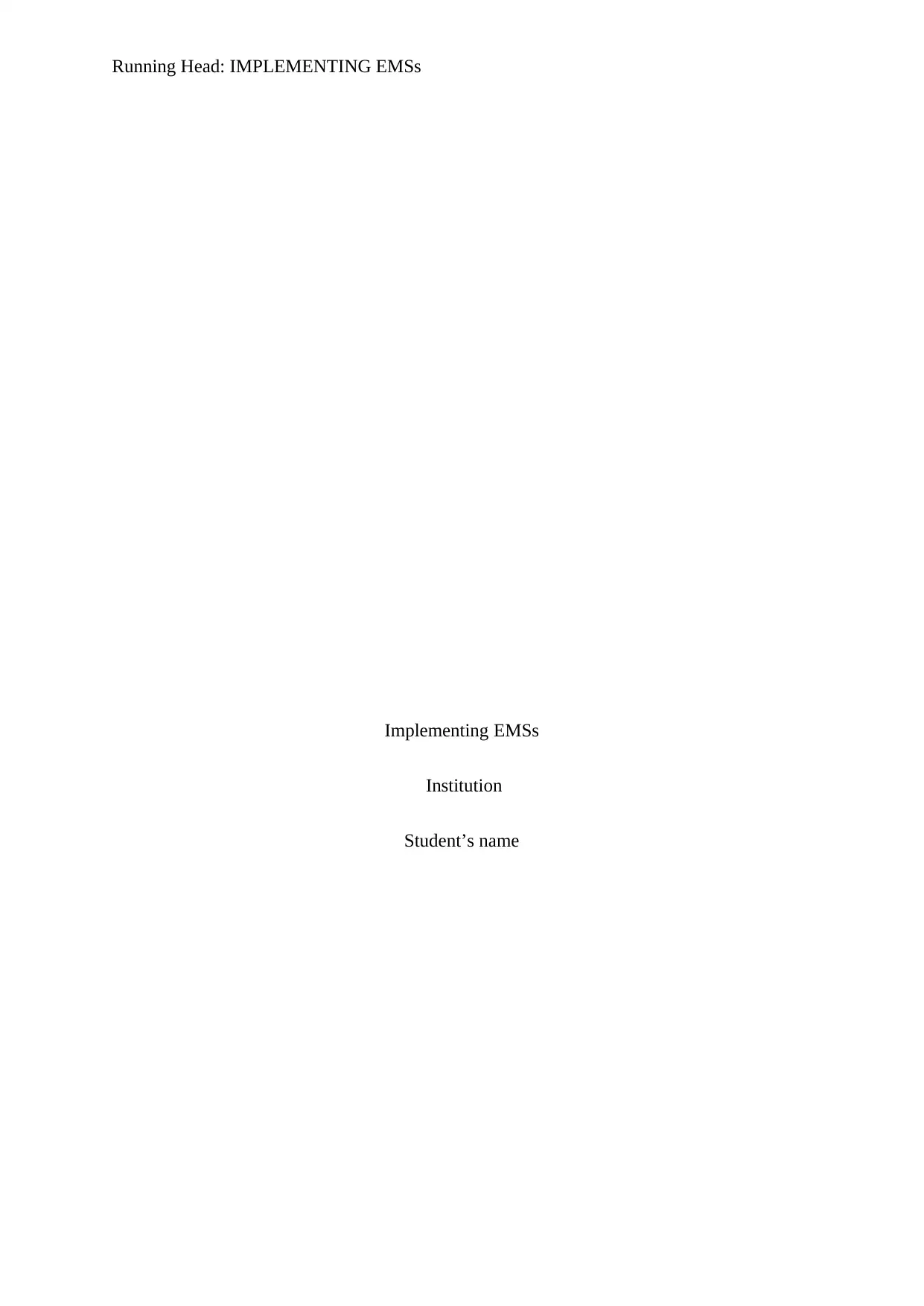
Running Head: IMPLEMENTING EMSs
Implementing EMSs
Institution
Student’s name
Implementing EMSs
Institution
Student’s name
Paraphrase This Document
Need a fresh take? Get an instant paraphrase of this document with our AI Paraphraser
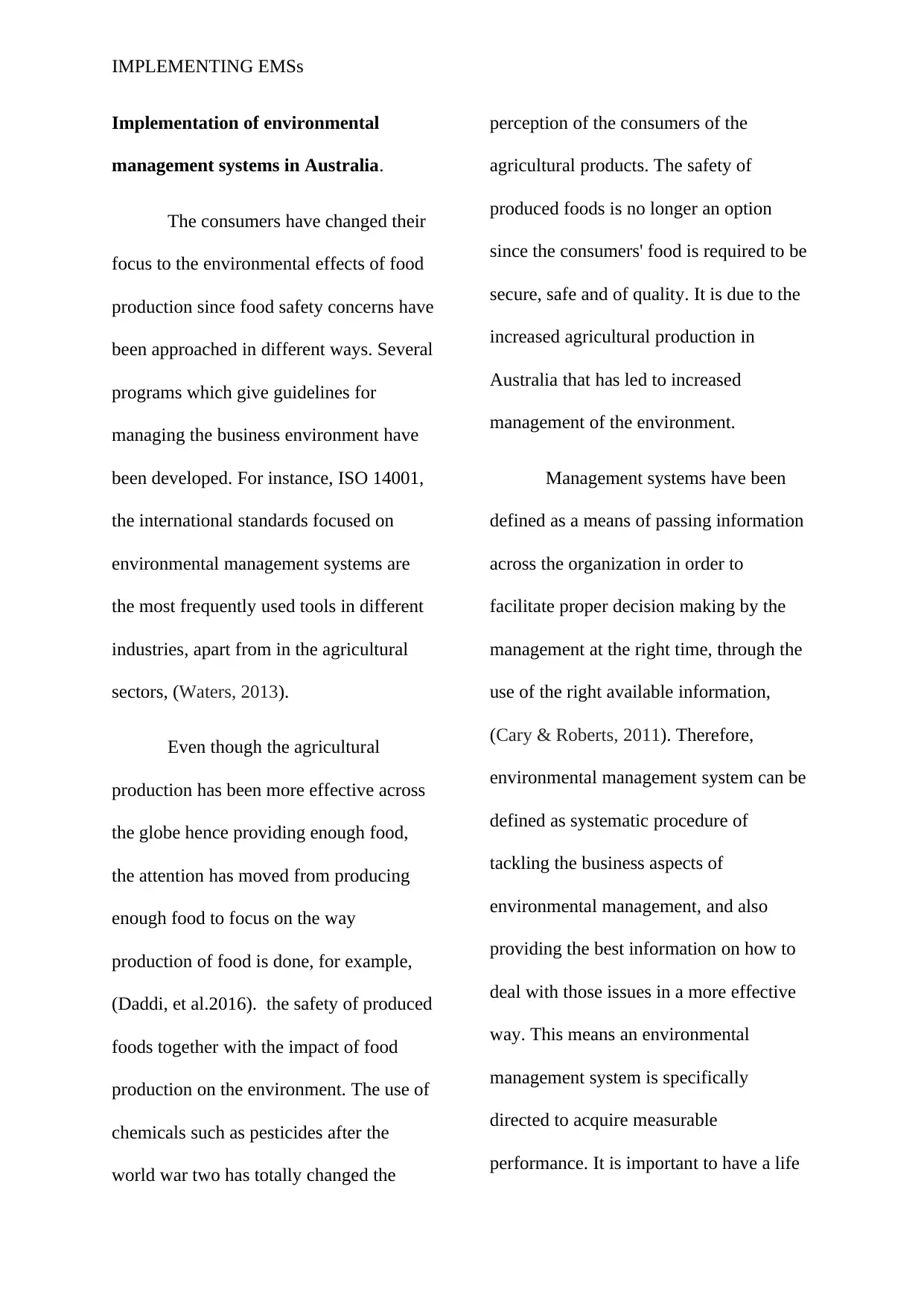
IMPLEMENTING EMSs
Implementation of environmental
management systems in Australia.
The consumers have changed their
focus to the environmental effects of food
production since food safety concerns have
been approached in different ways. Several
programs which give guidelines for
managing the business environment have
been developed. For instance, ISO 14001,
the international standards focused on
environmental management systems are
the most frequently used tools in different
industries, apart from in the agricultural
sectors, (Waters, 2013).
Even though the agricultural
production has been more effective across
the globe hence providing enough food,
the attention has moved from producing
enough food to focus on the way
production of food is done, for example,
(Daddi, et al.2016). the safety of produced
foods together with the impact of food
production on the environment. The use of
chemicals such as pesticides after the
world war two has totally changed the
perception of the consumers of the
agricultural products. The safety of
produced foods is no longer an option
since the consumers' food is required to be
secure, safe and of quality. It is due to the
increased agricultural production in
Australia that has led to increased
management of the environment.
Management systems have been
defined as a means of passing information
across the organization in order to
facilitate proper decision making by the
management at the right time, through the
use of the right available information,
(Cary & Roberts, 2011). Therefore,
environmental management system can be
defined as systematic procedure of
tackling the business aspects of
environmental management, and also
providing the best information on how to
deal with those issues in a more effective
way. This means an environmental
management system is specifically
directed to acquire measurable
performance. It is important to have a life
Implementation of environmental
management systems in Australia.
The consumers have changed their
focus to the environmental effects of food
production since food safety concerns have
been approached in different ways. Several
programs which give guidelines for
managing the business environment have
been developed. For instance, ISO 14001,
the international standards focused on
environmental management systems are
the most frequently used tools in different
industries, apart from in the agricultural
sectors, (Waters, 2013).
Even though the agricultural
production has been more effective across
the globe hence providing enough food,
the attention has moved from producing
enough food to focus on the way
production of food is done, for example,
(Daddi, et al.2016). the safety of produced
foods together with the impact of food
production on the environment. The use of
chemicals such as pesticides after the
world war two has totally changed the
perception of the consumers of the
agricultural products. The safety of
produced foods is no longer an option
since the consumers' food is required to be
secure, safe and of quality. It is due to the
increased agricultural production in
Australia that has led to increased
management of the environment.
Management systems have been
defined as a means of passing information
across the organization in order to
facilitate proper decision making by the
management at the right time, through the
use of the right available information,
(Cary & Roberts, 2011). Therefore,
environmental management system can be
defined as systematic procedure of
tackling the business aspects of
environmental management, and also
providing the best information on how to
deal with those issues in a more effective
way. This means an environmental
management system is specifically
directed to acquire measurable
performance. It is important to have a life
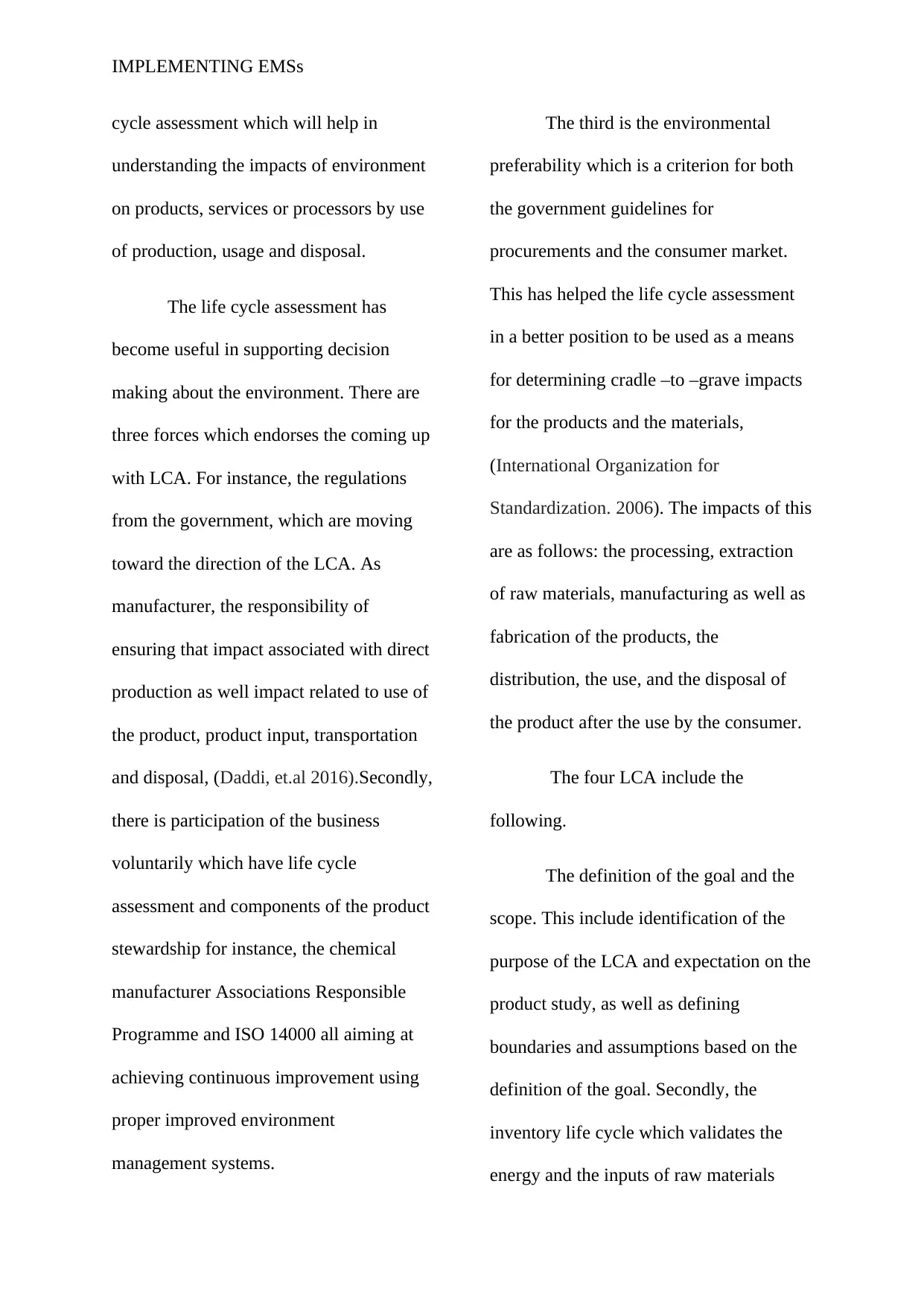
IMPLEMENTING EMSs
cycle assessment which will help in
understanding the impacts of environment
on products, services or processors by use
of production, usage and disposal.
The life cycle assessment has
become useful in supporting decision
making about the environment. There are
three forces which endorses the coming up
with LCA. For instance, the regulations
from the government, which are moving
toward the direction of the LCA. As
manufacturer, the responsibility of
ensuring that impact associated with direct
production as well impact related to use of
the product, product input, transportation
and disposal, (Daddi, et.al 2016).Secondly,
there is participation of the business
voluntarily which have life cycle
assessment and components of the product
stewardship for instance, the chemical
manufacturer Associations Responsible
Programme and ISO 14000 all aiming at
achieving continuous improvement using
proper improved environment
management systems.
The third is the environmental
preferability which is a criterion for both
the government guidelines for
procurements and the consumer market.
This has helped the life cycle assessment
in a better position to be used as a means
for determining cradle –to –grave impacts
for the products and the materials,
(International Organization for
Standardization. 2006). The impacts of this
are as follows: the processing, extraction
of raw materials, manufacturing as well as
fabrication of the products, the
distribution, the use, and the disposal of
the product after the use by the consumer.
The four LCA include the
following.
The definition of the goal and the
scope. This include identification of the
purpose of the LCA and expectation on the
product study, as well as defining
boundaries and assumptions based on the
definition of the goal. Secondly, the
inventory life cycle which validates the
energy and the inputs of raw materials
cycle assessment which will help in
understanding the impacts of environment
on products, services or processors by use
of production, usage and disposal.
The life cycle assessment has
become useful in supporting decision
making about the environment. There are
three forces which endorses the coming up
with LCA. For instance, the regulations
from the government, which are moving
toward the direction of the LCA. As
manufacturer, the responsibility of
ensuring that impact associated with direct
production as well impact related to use of
the product, product input, transportation
and disposal, (Daddi, et.al 2016).Secondly,
there is participation of the business
voluntarily which have life cycle
assessment and components of the product
stewardship for instance, the chemical
manufacturer Associations Responsible
Programme and ISO 14000 all aiming at
achieving continuous improvement using
proper improved environment
management systems.
The third is the environmental
preferability which is a criterion for both
the government guidelines for
procurements and the consumer market.
This has helped the life cycle assessment
in a better position to be used as a means
for determining cradle –to –grave impacts
for the products and the materials,
(International Organization for
Standardization. 2006). The impacts of this
are as follows: the processing, extraction
of raw materials, manufacturing as well as
fabrication of the products, the
distribution, the use, and the disposal of
the product after the use by the consumer.
The four LCA include the
following.
The definition of the goal and the
scope. This include identification of the
purpose of the LCA and expectation on the
product study, as well as defining
boundaries and assumptions based on the
definition of the goal. Secondly, the
inventory life cycle which validates the
energy and the inputs of raw materials
⊘ This is a preview!⊘
Do you want full access?
Subscribe today to unlock all pages.

Trusted by 1+ million students worldwide
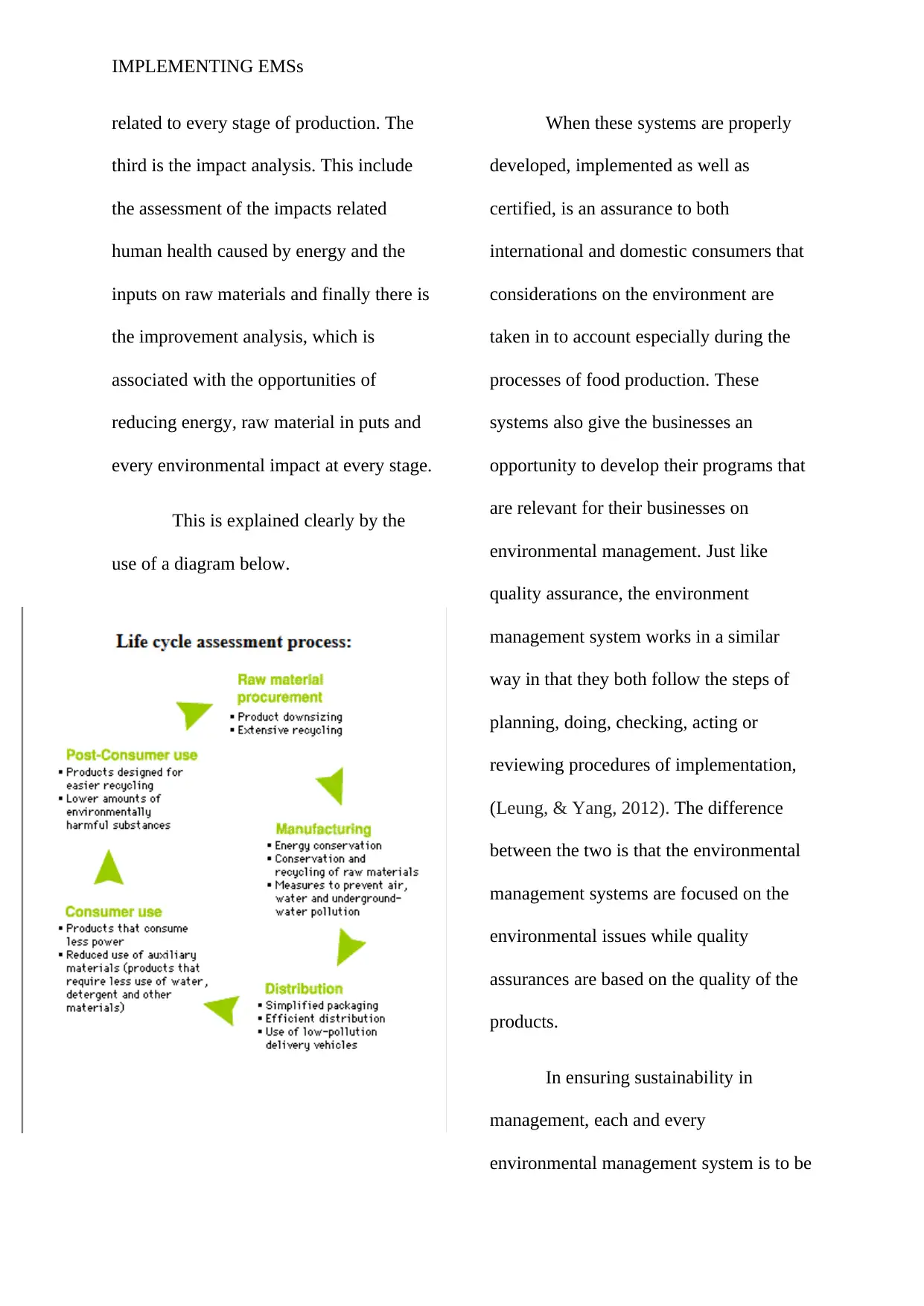
IMPLEMENTING EMSs
related to every stage of production. The
third is the impact analysis. This include
the assessment of the impacts related
human health caused by energy and the
inputs on raw materials and finally there is
the improvement analysis, which is
associated with the opportunities of
reducing energy, raw material in puts and
every environmental impact at every stage.
This is explained clearly by the
use of a diagram below.
When these systems are properly
developed, implemented as well as
certified, is an assurance to both
international and domestic consumers that
considerations on the environment are
taken in to account especially during the
processes of food production. These
systems also give the businesses an
opportunity to develop their programs that
are relevant for their businesses on
environmental management. Just like
quality assurance, the environment
management system works in a similar
way in that they both follow the steps of
planning, doing, checking, acting or
reviewing procedures of implementation,
(Leung, & Yang, 2012). The difference
between the two is that the environmental
management systems are focused on the
environmental issues while quality
assurances are based on the quality of the
products.
In ensuring sustainability in
management, each and every
environmental management system is to be
related to every stage of production. The
third is the impact analysis. This include
the assessment of the impacts related
human health caused by energy and the
inputs on raw materials and finally there is
the improvement analysis, which is
associated with the opportunities of
reducing energy, raw material in puts and
every environmental impact at every stage.
This is explained clearly by the
use of a diagram below.
When these systems are properly
developed, implemented as well as
certified, is an assurance to both
international and domestic consumers that
considerations on the environment are
taken in to account especially during the
processes of food production. These
systems also give the businesses an
opportunity to develop their programs that
are relevant for their businesses on
environmental management. Just like
quality assurance, the environment
management system works in a similar
way in that they both follow the steps of
planning, doing, checking, acting or
reviewing procedures of implementation,
(Leung, & Yang, 2012). The difference
between the two is that the environmental
management systems are focused on the
environmental issues while quality
assurances are based on the quality of the
products.
In ensuring sustainability in
management, each and every
environmental management system is to be
Paraphrase This Document
Need a fresh take? Get an instant paraphrase of this document with our AI Paraphraser
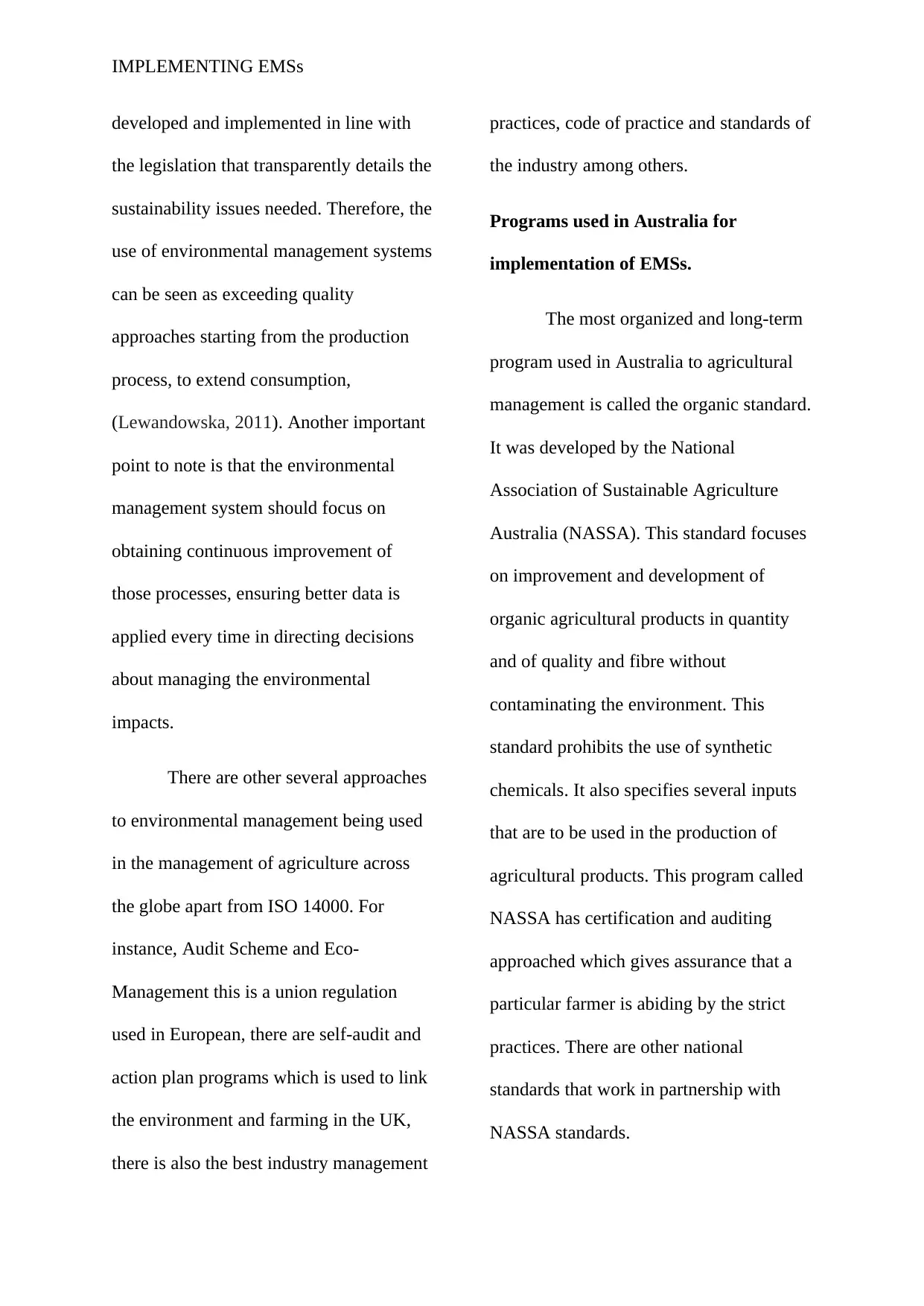
IMPLEMENTING EMSs
developed and implemented in line with
the legislation that transparently details the
sustainability issues needed. Therefore, the
use of environmental management systems
can be seen as exceeding quality
approaches starting from the production
process, to extend consumption,
(Lewandowska, 2011). Another important
point to note is that the environmental
management system should focus on
obtaining continuous improvement of
those processes, ensuring better data is
applied every time in directing decisions
about managing the environmental
impacts.
There are other several approaches
to environmental management being used
in the management of agriculture across
the globe apart from ISO 14000. For
instance, Audit Scheme and Eco-
Management this is a union regulation
used in European, there are self-audit and
action plan programs which is used to link
the environment and farming in the UK,
there is also the best industry management
practices, code of practice and standards of
the industry among others.
Programs used in Australia for
implementation of EMSs.
The most organized and long-term
program used in Australia to agricultural
management is called the organic standard.
It was developed by the National
Association of Sustainable Agriculture
Australia (NASSA). This standard focuses
on improvement and development of
organic agricultural products in quantity
and of quality and fibre without
contaminating the environment. This
standard prohibits the use of synthetic
chemicals. It also specifies several inputs
that are to be used in the production of
agricultural products. This program called
NASSA has certification and auditing
approached which gives assurance that a
particular farmer is abiding by the strict
practices. There are other national
standards that work in partnership with
NASSA standards.
developed and implemented in line with
the legislation that transparently details the
sustainability issues needed. Therefore, the
use of environmental management systems
can be seen as exceeding quality
approaches starting from the production
process, to extend consumption,
(Lewandowska, 2011). Another important
point to note is that the environmental
management system should focus on
obtaining continuous improvement of
those processes, ensuring better data is
applied every time in directing decisions
about managing the environmental
impacts.
There are other several approaches
to environmental management being used
in the management of agriculture across
the globe apart from ISO 14000. For
instance, Audit Scheme and Eco-
Management this is a union regulation
used in European, there are self-audit and
action plan programs which is used to link
the environment and farming in the UK,
there is also the best industry management
practices, code of practice and standards of
the industry among others.
Programs used in Australia for
implementation of EMSs.
The most organized and long-term
program used in Australia to agricultural
management is called the organic standard.
It was developed by the National
Association of Sustainable Agriculture
Australia (NASSA). This standard focuses
on improvement and development of
organic agricultural products in quantity
and of quality and fibre without
contaminating the environment. This
standard prohibits the use of synthetic
chemicals. It also specifies several inputs
that are to be used in the production of
agricultural products. This program called
NASSA has certification and auditing
approached which gives assurance that a
particular farmer is abiding by the strict
practices. There are other national
standards that work in partnership with
NASSA standards.
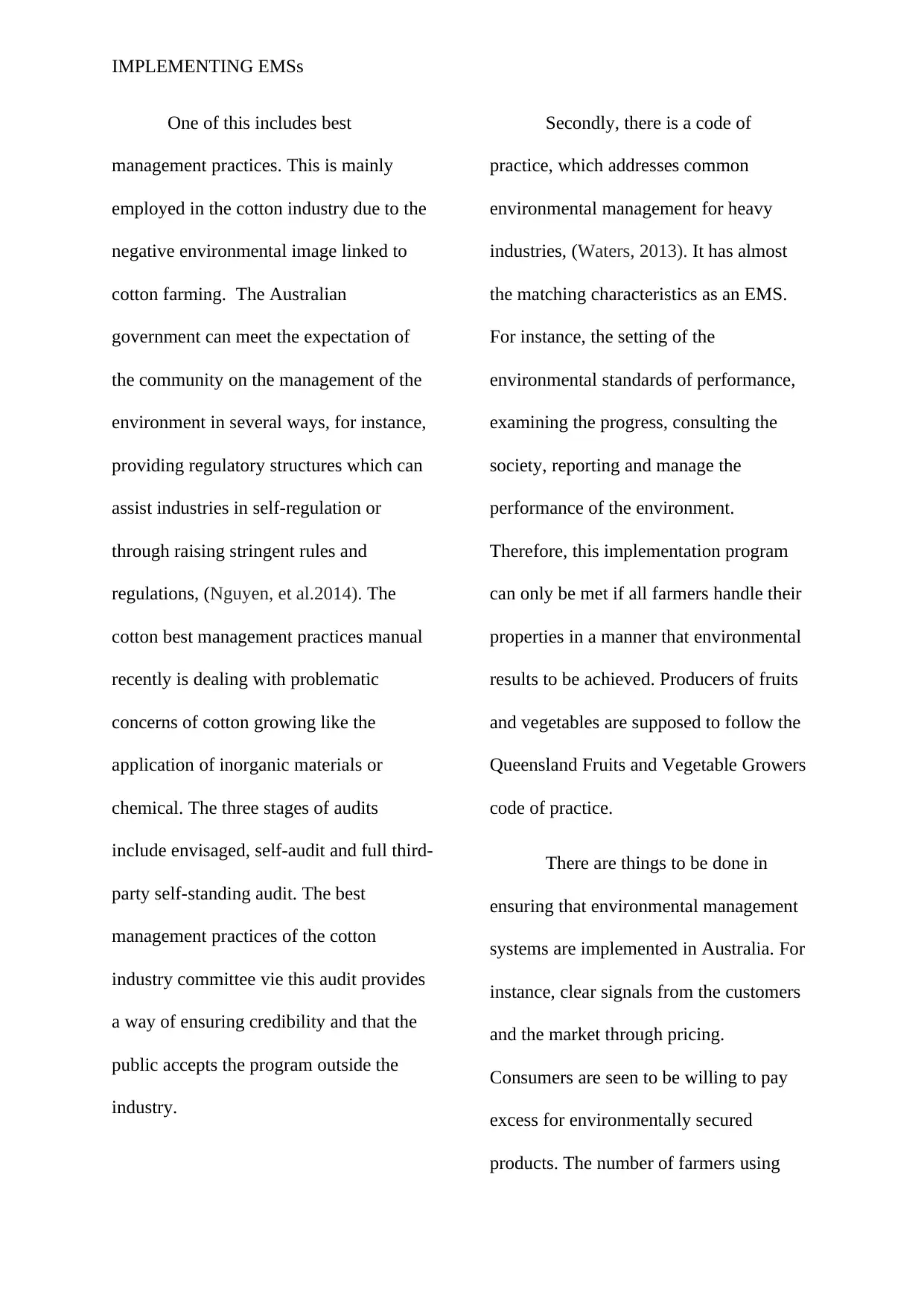
IMPLEMENTING EMSs
One of this includes best
management practices. This is mainly
employed in the cotton industry due to the
negative environmental image linked to
cotton farming. The Australian
government can meet the expectation of
the community on the management of the
environment in several ways, for instance,
providing regulatory structures which can
assist industries in self-regulation or
through raising stringent rules and
regulations, (Nguyen, et al.2014). The
cotton best management practices manual
recently is dealing with problematic
concerns of cotton growing like the
application of inorganic materials or
chemical. The three stages of audits
include envisaged, self-audit and full third-
party self-standing audit. The best
management practices of the cotton
industry committee vie this audit provides
a way of ensuring credibility and that the
public accepts the program outside the
industry.
Secondly, there is a code of
practice, which addresses common
environmental management for heavy
industries, (Waters, 2013). It has almost
the matching characteristics as an EMS.
For instance, the setting of the
environmental standards of performance,
examining the progress, consulting the
society, reporting and manage the
performance of the environment.
Therefore, this implementation program
can only be met if all farmers handle their
properties in a manner that environmental
results to be achieved. Producers of fruits
and vegetables are supposed to follow the
Queensland Fruits and Vegetable Growers
code of practice.
There are things to be done in
ensuring that environmental management
systems are implemented in Australia. For
instance, clear signals from the customers
and the market through pricing.
Consumers are seen to be willing to pay
excess for environmentally secured
products. The number of farmers using
One of this includes best
management practices. This is mainly
employed in the cotton industry due to the
negative environmental image linked to
cotton farming. The Australian
government can meet the expectation of
the community on the management of the
environment in several ways, for instance,
providing regulatory structures which can
assist industries in self-regulation or
through raising stringent rules and
regulations, (Nguyen, et al.2014). The
cotton best management practices manual
recently is dealing with problematic
concerns of cotton growing like the
application of inorganic materials or
chemical. The three stages of audits
include envisaged, self-audit and full third-
party self-standing audit. The best
management practices of the cotton
industry committee vie this audit provides
a way of ensuring credibility and that the
public accepts the program outside the
industry.
Secondly, there is a code of
practice, which addresses common
environmental management for heavy
industries, (Waters, 2013). It has almost
the matching characteristics as an EMS.
For instance, the setting of the
environmental standards of performance,
examining the progress, consulting the
society, reporting and manage the
performance of the environment.
Therefore, this implementation program
can only be met if all farmers handle their
properties in a manner that environmental
results to be achieved. Producers of fruits
and vegetables are supposed to follow the
Queensland Fruits and Vegetable Growers
code of practice.
There are things to be done in
ensuring that environmental management
systems are implemented in Australia. For
instance, clear signals from the customers
and the market through pricing.
Consumers are seen to be willing to pay
excess for environmentally secured
products. The number of farmers using
⊘ This is a preview!⊘
Do you want full access?
Subscribe today to unlock all pages.

Trusted by 1+ million students worldwide
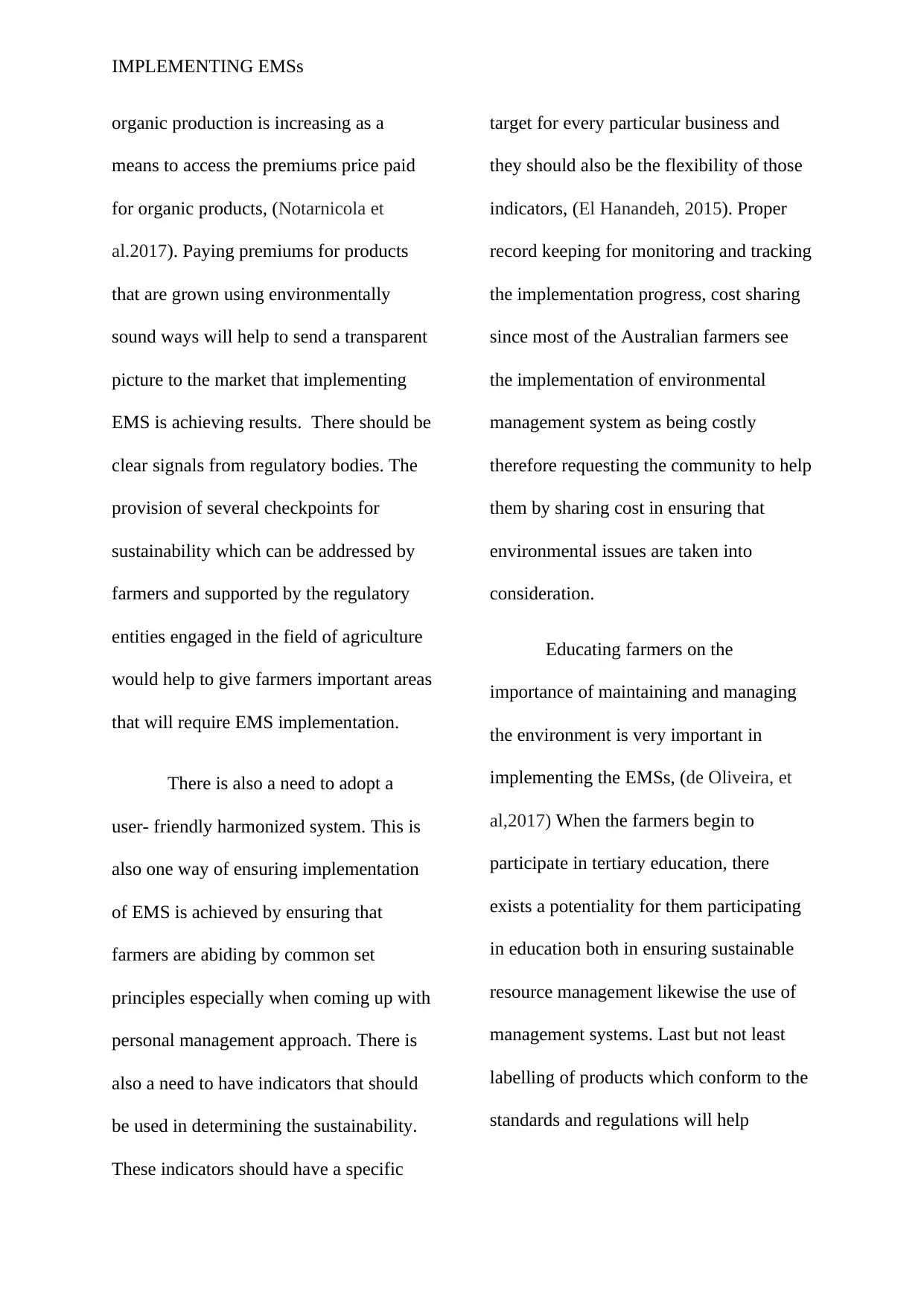
IMPLEMENTING EMSs
organic production is increasing as a
means to access the premiums price paid
for organic products, (Notarnicola et
al.2017). Paying premiums for products
that are grown using environmentally
sound ways will help to send a transparent
picture to the market that implementing
EMS is achieving results. There should be
clear signals from regulatory bodies. The
provision of several checkpoints for
sustainability which can be addressed by
farmers and supported by the regulatory
entities engaged in the field of agriculture
would help to give farmers important areas
that will require EMS implementation.
There is also a need to adopt a
user- friendly harmonized system. This is
also one way of ensuring implementation
of EMS is achieved by ensuring that
farmers are abiding by common set
principles especially when coming up with
personal management approach. There is
also a need to have indicators that should
be used in determining the sustainability.
These indicators should have a specific
target for every particular business and
they should also be the flexibility of those
indicators, (El Hanandeh, 2015). Proper
record keeping for monitoring and tracking
the implementation progress, cost sharing
since most of the Australian farmers see
the implementation of environmental
management system as being costly
therefore requesting the community to help
them by sharing cost in ensuring that
environmental issues are taken into
consideration.
Educating farmers on the
importance of maintaining and managing
the environment is very important in
implementing the EMSs, (de Oliveira, et
al,2017) When the farmers begin to
participate in tertiary education, there
exists a potentiality for them participating
in education both in ensuring sustainable
resource management likewise the use of
management systems. Last but not least
labelling of products which conform to the
standards and regulations will help
organic production is increasing as a
means to access the premiums price paid
for organic products, (Notarnicola et
al.2017). Paying premiums for products
that are grown using environmentally
sound ways will help to send a transparent
picture to the market that implementing
EMS is achieving results. There should be
clear signals from regulatory bodies. The
provision of several checkpoints for
sustainability which can be addressed by
farmers and supported by the regulatory
entities engaged in the field of agriculture
would help to give farmers important areas
that will require EMS implementation.
There is also a need to adopt a
user- friendly harmonized system. This is
also one way of ensuring implementation
of EMS is achieved by ensuring that
farmers are abiding by common set
principles especially when coming up with
personal management approach. There is
also a need to have indicators that should
be used in determining the sustainability.
These indicators should have a specific
target for every particular business and
they should also be the flexibility of those
indicators, (El Hanandeh, 2015). Proper
record keeping for monitoring and tracking
the implementation progress, cost sharing
since most of the Australian farmers see
the implementation of environmental
management system as being costly
therefore requesting the community to help
them by sharing cost in ensuring that
environmental issues are taken into
consideration.
Educating farmers on the
importance of maintaining and managing
the environment is very important in
implementing the EMSs, (de Oliveira, et
al,2017) When the farmers begin to
participate in tertiary education, there
exists a potentiality for them participating
in education both in ensuring sustainable
resource management likewise the use of
management systems. Last but not least
labelling of products which conform to the
standards and regulations will help
Paraphrase This Document
Need a fresh take? Get an instant paraphrase of this document with our AI Paraphraser
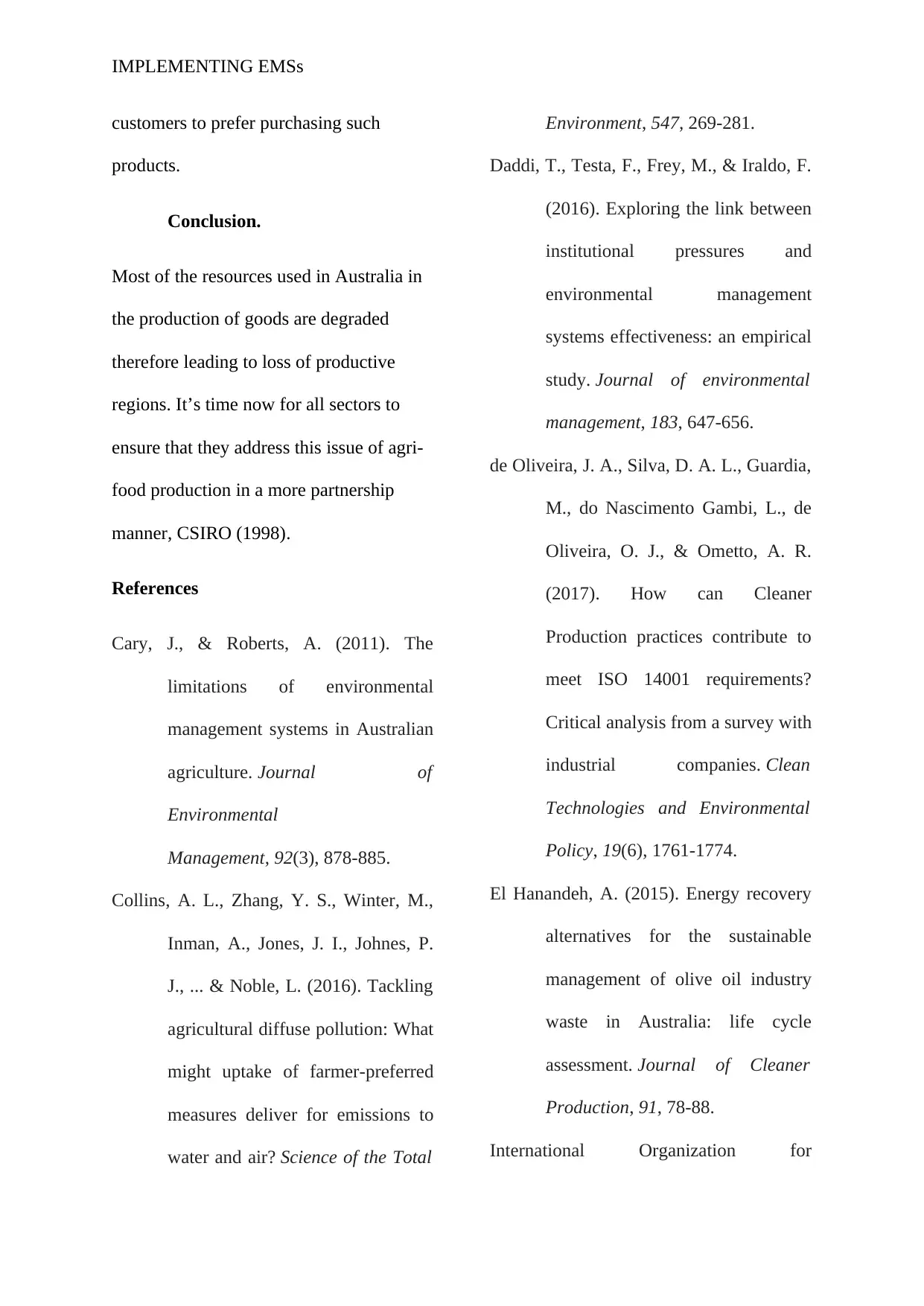
IMPLEMENTING EMSs
customers to prefer purchasing such
products.
Conclusion.
Most of the resources used in Australia in
the production of goods are degraded
therefore leading to loss of productive
regions. It’s time now for all sectors to
ensure that they address this issue of agri-
food production in a more partnership
manner, CSIRO (1998).
References
Cary, J., & Roberts, A. (2011). The
limitations of environmental
management systems in Australian
agriculture. Journal of
Environmental
Management, 92(3), 878-885.
Collins, A. L., Zhang, Y. S., Winter, M.,
Inman, A., Jones, J. I., Johnes, P.
J., ... & Noble, L. (2016). Tackling
agricultural diffuse pollution: What
might uptake of farmer-preferred
measures deliver for emissions to
water and air? Science of the Total
Environment, 547, 269-281.
Daddi, T., Testa, F., Frey, M., & Iraldo, F.
(2016). Exploring the link between
institutional pressures and
environmental management
systems effectiveness: an empirical
study. Journal of environmental
management, 183, 647-656.
de Oliveira, J. A., Silva, D. A. L., Guardia,
M., do Nascimento Gambi, L., de
Oliveira, O. J., & Ometto, A. R.
(2017). How can Cleaner
Production practices contribute to
meet ISO 14001 requirements?
Critical analysis from a survey with
industrial companies. Clean
Technologies and Environmental
Policy, 19(6), 1761-1774.
El Hanandeh, A. (2015). Energy recovery
alternatives for the sustainable
management of olive oil industry
waste in Australia: life cycle
assessment. Journal of Cleaner
Production, 91, 78-88.
International Organization for
customers to prefer purchasing such
products.
Conclusion.
Most of the resources used in Australia in
the production of goods are degraded
therefore leading to loss of productive
regions. It’s time now for all sectors to
ensure that they address this issue of agri-
food production in a more partnership
manner, CSIRO (1998).
References
Cary, J., & Roberts, A. (2011). The
limitations of environmental
management systems in Australian
agriculture. Journal of
Environmental
Management, 92(3), 878-885.
Collins, A. L., Zhang, Y. S., Winter, M.,
Inman, A., Jones, J. I., Johnes, P.
J., ... & Noble, L. (2016). Tackling
agricultural diffuse pollution: What
might uptake of farmer-preferred
measures deliver for emissions to
water and air? Science of the Total
Environment, 547, 269-281.
Daddi, T., Testa, F., Frey, M., & Iraldo, F.
(2016). Exploring the link between
institutional pressures and
environmental management
systems effectiveness: an empirical
study. Journal of environmental
management, 183, 647-656.
de Oliveira, J. A., Silva, D. A. L., Guardia,
M., do Nascimento Gambi, L., de
Oliveira, O. J., & Ometto, A. R.
(2017). How can Cleaner
Production practices contribute to
meet ISO 14001 requirements?
Critical analysis from a survey with
industrial companies. Clean
Technologies and Environmental
Policy, 19(6), 1761-1774.
El Hanandeh, A. (2015). Energy recovery
alternatives for the sustainable
management of olive oil industry
waste in Australia: life cycle
assessment. Journal of Cleaner
Production, 91, 78-88.
International Organization for
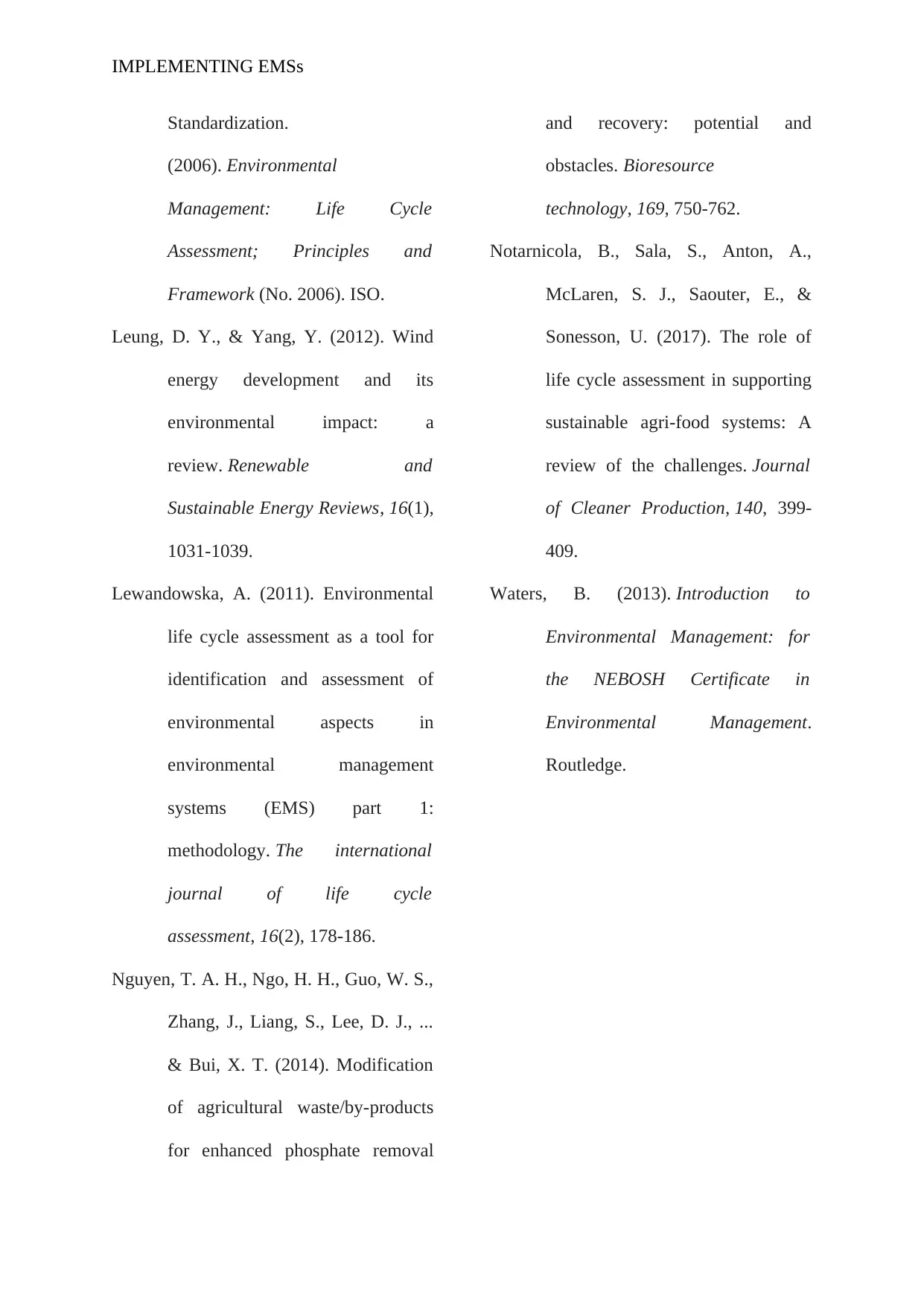
IMPLEMENTING EMSs
Standardization.
(2006). Environmental
Management: Life Cycle
Assessment; Principles and
Framework (No. 2006). ISO.
Leung, D. Y., & Yang, Y. (2012). Wind
energy development and its
environmental impact: a
review. Renewable and
Sustainable Energy Reviews, 16(1),
1031-1039.
Lewandowska, A. (2011). Environmental
life cycle assessment as a tool for
identification and assessment of
environmental aspects in
environmental management
systems (EMS) part 1:
methodology. The international
journal of life cycle
assessment, 16(2), 178-186.
Nguyen, T. A. H., Ngo, H. H., Guo, W. S.,
Zhang, J., Liang, S., Lee, D. J., ...
& Bui, X. T. (2014). Modification
of agricultural waste/by-products
for enhanced phosphate removal
and recovery: potential and
obstacles. Bioresource
technology, 169, 750-762.
Notarnicola, B., Sala, S., Anton, A.,
McLaren, S. J., Saouter, E., &
Sonesson, U. (2017). The role of
life cycle assessment in supporting
sustainable agri-food systems: A
review of the challenges. Journal
of Cleaner Production, 140, 399-
409.
Waters, B. (2013). Introduction to
Environmental Management: for
the NEBOSH Certificate in
Environmental Management.
Routledge.
Standardization.
(2006). Environmental
Management: Life Cycle
Assessment; Principles and
Framework (No. 2006). ISO.
Leung, D. Y., & Yang, Y. (2012). Wind
energy development and its
environmental impact: a
review. Renewable and
Sustainable Energy Reviews, 16(1),
1031-1039.
Lewandowska, A. (2011). Environmental
life cycle assessment as a tool for
identification and assessment of
environmental aspects in
environmental management
systems (EMS) part 1:
methodology. The international
journal of life cycle
assessment, 16(2), 178-186.
Nguyen, T. A. H., Ngo, H. H., Guo, W. S.,
Zhang, J., Liang, S., Lee, D. J., ...
& Bui, X. T. (2014). Modification
of agricultural waste/by-products
for enhanced phosphate removal
and recovery: potential and
obstacles. Bioresource
technology, 169, 750-762.
Notarnicola, B., Sala, S., Anton, A.,
McLaren, S. J., Saouter, E., &
Sonesson, U. (2017). The role of
life cycle assessment in supporting
sustainable agri-food systems: A
review of the challenges. Journal
of Cleaner Production, 140, 399-
409.
Waters, B. (2013). Introduction to
Environmental Management: for
the NEBOSH Certificate in
Environmental Management.
Routledge.
⊘ This is a preview!⊘
Do you want full access?
Subscribe today to unlock all pages.

Trusted by 1+ million students worldwide
1 out of 9
Related Documents
Your All-in-One AI-Powered Toolkit for Academic Success.
+13062052269
info@desklib.com
Available 24*7 on WhatsApp / Email
![[object Object]](/_next/static/media/star-bottom.7253800d.svg)
Unlock your academic potential
Copyright © 2020–2025 A2Z Services. All Rights Reserved. Developed and managed by ZUCOL.




